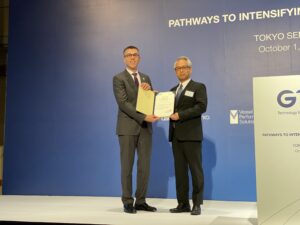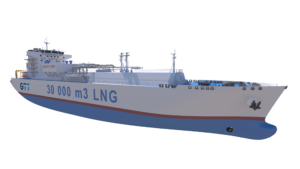29 October 2024 – ClassNK has issued an approval in principle (AiP) for a 30,000 m³ LNG carrier equipped with two Mark III Flex membrane tanks, developed by GTT. The vessel’s ballast tank design and ballasting operations allow for the elimination of filing limits, enhancing operational flexibility. The AiP demonstrates the feasibility of this design concept.

Right: Mr. Masaki Matsunaga, Executive Vice President / Director of Plan Approval and Technical Solution Division, ClassNK
In LNG carriers with membrane tanks, filing limits are often required based on the strength assessments against sloshing loads, which can pose challenges, especially in feeder transportation.
The LNG carrier developed by GTT has ballast tanks divided into upper and lower sections. During ballasting operations, water is pumped into the upper ballast tanks first to maintain a lower metacentric height (GM) while satisfying the stability requirements, reducing roll acceleration. This helps prevent excessive sloshing loads at any cargo filling level, allowing unrestricted filling levels and eliminating prior filling limits.
ClassNK conducted a design review based on part N of its ‘Rules and Guidance for the Survey and Construction of Steel Ships’, which incorporates the IGC Code. Upon confirming compliance with the prescribed requirements, ClassNK issued the AiP. In assessing the feasibility of the concept, ClassNK identified key conditions and parameters related to ballast tank design and ballasting operations that shipyards and operators should follow during design and operation.

ClassNK will continually strive to contribute to the advancement and implementation of new technologies through safety assessments and more.
Approval in Principle (AiP):
At the initial stage of designing or before the specific target ship to be implemented is decided, the design is examined based on the existing regulations such as international conventions and ship classification rules, and an Approval in Principle (AiP) is issued as proof of conformity with requirements. It also prevents rework of regulatory aspects in the post-process, shortens the examination time at the time of class registration, and can be used as a technical basis for external appeal of the design status. For more information, visit our website.
